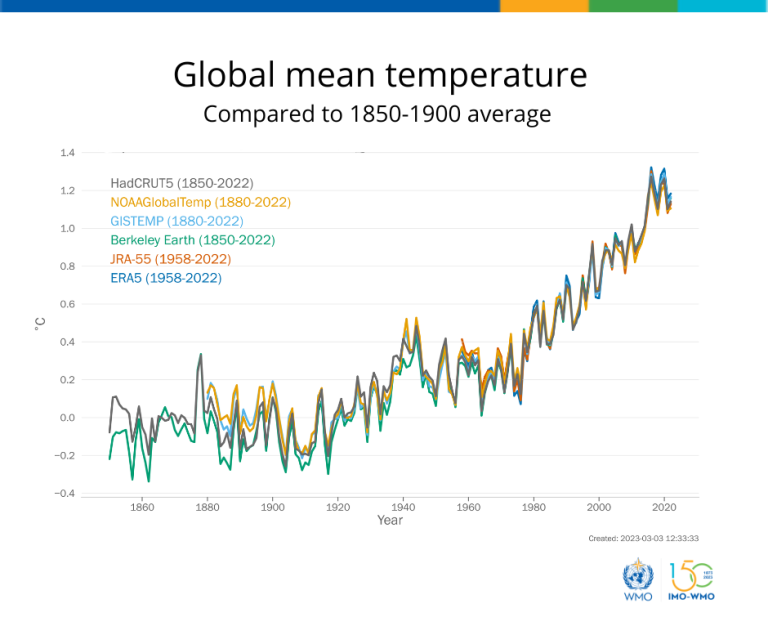WMO publishes global update of climate datasets
Comprehensive new climate datasets have just been published after a massive two-year effort by members of the World Meteorological Organization (WMO) and the US National Centers for Environmental Information (NCEI). The updated information from more than 140 countries and thousands of locations is the climate equivalent of a census and is vital for monitoring climate change and for climate sensitive sectors.

In order to assess whether a given day, week, month or year is warmer or wetter than average, WMO uses 30-year-long baselines, known as Climatological Standard Normals or CLINO. These are averages of climatological data over a 30-year period. It’s important to use a long-term average because of the natural variability in our climate.
The US National Centers for Environmental Information (NCEI) have just issued the new WMO Climatological Standard Normals 1991-2020 to replace the previous baseline of 1981-2010. Additional countries will still be submitting their updates in the coming months.
WMO recommends that the 30-year standard reference periods be updated every decade to better reflect the changing climate and its influence on our day-to-day weather experience.
“Rising atmospheric concentrations of greenhouse gases are changing the Earth’s climate much faster than before. As a result, decision-makers in climate-sensitive sectors and industries such as water management, energy, health, agriculture and viticulture could be basing important decisions on information that may be out of date,” says Dr. Omar Baddour, chief of climate monitoring at WMO.
“Thus, it is necessary to update the climate normals for operational services for decision-making, for example for forecasts of peak energy loads and recommendations on crop selection and planting times,” he says.
Until the end of 2020, the most current and widely used standard reference period for calculating climate normals was the 30-year period 1981-2010. The World Meteorological Congress recommended that the new 30-year baseline, 1991-2020, should be adopted globally and pledged support to Members to help them update their figures. NCEI’s new publication is in line with that recommendation.
''Weather and Climate services are as robust as the underlying data is, NCEI has been collaborating with WMO to make sure this dataset is consistently quality controlled and well-packaged and delivered to meet the need of international communities and WMO Members,'” says Jay Lawrimore, a meteorologist in the dataset section of NCEI.
However, for the purposes of historical comparison and climate change monitoring, WMO still recommends the continuation of the 1961-1990 period for the computation and tracking global climate anomalies relative to a fixed and common reference period.
For the purpose of Paris Agreement on climate change and its temperature targets, WMO also uses the 1850-1900 period as a pre-industrial baseline for tracking global temperature increase in its annual State of the Global Climate report. The average global temperature in 2022 was about 1.15 °C above the pre-industrial baseline.

Exhaustive update process
“The publication of a consolidated global CLINO dataset assembled from Members’ submissions represents a fundamental flagship product of WMO and its predecessor IMO for almost 100 years. Graded as a WMO mandatory publication, CLINO underpin many national, regional, and global climate and weather applications as well as national and international norms and statistics,” says Peer Hechler, a WMO scientist involved in updating the norms.
“Today’s increasingly powerful computers and climate data management systems make it much easier to conduct more frequent updates, which involve analyzing massive amounts of climate data. Another advantage of decadal updates is that they will make it possible to incorporate data from newly established weather stations into the normals more rapidly,” he says.
“But for developing countries, which have significant gaps in their data collection and processing capacity, this poses a real challenge,” says Mr Hechler.
WMO was concerned that missing CLINO 1991–2020 would hamper the quality of operational monitoring and prediction products, such as El Niño/La Niña monitoring, State of Climate reports, seasonal forecasts etc.
WMO therefore issued several calls for submission of CLINO 1991–2020. It organized regional and technical consultations for more than 700 experts from more than 100 Members to:
promote the calculation and WMO collection of CLINO 1991–2020,
facilitate the exchange of information among NMHSs,
introduce software tools for calculating and formatting CLINO and
discuss Members’ challenges in a question-and-answer format.
It is anticipated that additional Members will submit updated CLINO data in the coming months and WMO will publish the complete update in 2024.

